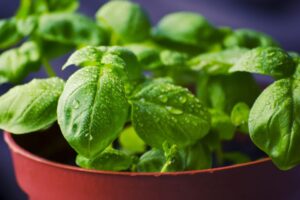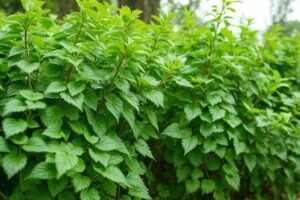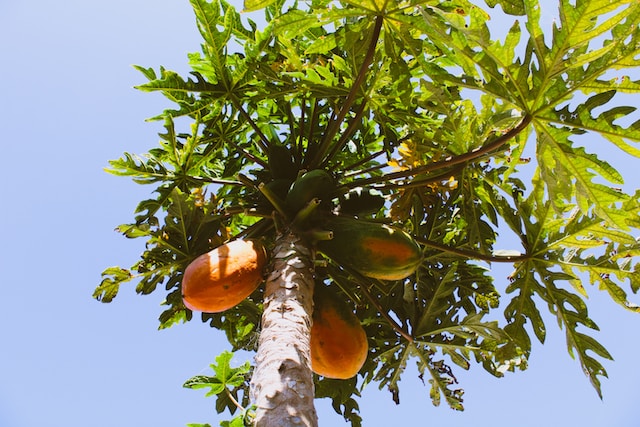Introduction
Papaya trees are a delicious and nutritious addition to your garden. They’re easy to grow and don’t require much maintenance, making them great for novice gardeners who want to start their own fruit-bearing plants from scratch. Papayas are in the same family as the custard apple, soursop and cherimoya, but they have their own unique flavor that’s hard not to love! The best part about growing papayas is that you get two plants for the price of one: not only does it produce delicious fruits when fully grown, but it also produces new baby trees called “pups” at its base every year. This means that once you have one mature papaya tree in your yard—or even better yet on your patio or balcony—you can continue growing them indefinitely through propagation methods like cloning or grafting onto other rootstock (more on those below).
Papaya is a tropical plant, so it grows best in warm, humid regions.
The best growing conditions for papaya trees are warm temperatures of about 70 degrees Fahrenheit (21 degrees Celsius) and high humidity levels.
If you live in an area that doesn’t have these ideal conditions all year round, your papaya tree will still grow well–but it may take longer to bear fruit than if you were able to provide its ideal environment all year long.
You can grow papayas from seeds, but it’s much easier to grow them from seedlings.
Growing from seeds is more difficult than growing from seedlings. If you’re just starting out with papaya trees, it’s best to buy a few young plants instead of trying to germinate your own seeds.
Growing your own papayas can be done by planting the seeds directly into the ground or in containers indoors (it will take longer). But if you choose this option, make sure that they have plenty of sunlight and space so they can grow strong roots before transplanting them into the ground outside when they reach about 6 inches tall–and keep in mind that it may take up to 2 years before they bear fruit!
The other option is purchasing young plants at nurseries or online stores; these are easier since all of their growing needs have already been met by someone else who knows what they’re doing! They’ll also cost less than buying seeds individually ($5-$10 versus $15-$25 per pack).
Papaya trees should always be grown in full sun with plenty of water and fertilizer.
To ensure you get the best possible results from your papaya tree, it’s important to follow these guidelines:
- The best time to plant a papaya tree is between November and February. This gives the plant enough time to establish itself before summer heat arrives.
- Make sure you have plenty of room around the base of your papaya tree so that its roots can grow freely without being constricted by other plants or structures.
- Papayas need full sun exposure in order to thrive; they cannot tolerate shade at all! Make sure there aren’t any large trees nearby that might cast shadows over your papaya patch during most hours of daylight (between 9am-5pm). If there is no way around this issue and you still want some shade for yourself or other plants, try planting some trees around them so they get some relief from direct sunlight as well as windy conditions near fences or buildings that face southward towards where we live here in Southern California.”
If you are growing your papaya indoors, it needs a warm spot with plenty of light.
Papaya plants can grow in a range of temperatures. They prefer warmth, but they’re not fussy about it. You can safely plant your papaya tree in an area with temperatures ranging from 60 to 90 degrees Fahrenheit (16 to 32 degrees Celsius).
If you’re growing your papaya indoors, it needs plenty of light–at least six hours per day. If you live in an area that gets less than this amount of sun during the winter months or if you don’t have enough window space for such a large plant, consider using artificial lighting instead. You’ll need at least one fluorescent bulb that produces around 2,500 lumens per square foot (25 watts) and two T5 high output bulbs producing 10 watts each per square foot (20 watts total).
For optimum growth, aim for 12 hours of sunlight a day at least.
If you’re growing a papaya tree outdoors, it’s best to give your plant as much direct sunlight as possible. The more direct sunlight your papaya tree receives, the better! If you live in an area with long summers and short winters, then you should be able to get away with providing 12 hours of sunlight every day (or nearly so). However, if your climate is colder or cloudier than this–especially during winter–then try to keep the plant in full sun at least six hours per day.
If you live somewhere where there isn’t enough natural light available during wintertime (such as northern regions), then consider getting an artificial grow light instead of moving south for the winter months!
Watering your papaya tree properly is crucial to its health and growth.
The best way to water a papaya tree is by using drip irrigation, but if you don’t have one of these systems installed, you can use a watering can or hose with a sprinkler head on it.
Your watering frequency depends on the weather, soil type (if it’s sandy or clay), and plant size–but generally speaking: if it hasn’t rained for more than 7 days and there’s no rain in sight within the next 2 weeks…your plant needs some H2O!
When you first plant your tree outdoors, water it for 3-4 minutes every day for about a week until the soil is moist enough that you won’t need to water it again for several days.
After that, water only when there is no rain in the forecast for at least three days. The ideal range of humidity is 60%-80%. You can check this by measuring the amount of moisture in the soil with a moisture meter or digging down 2 feet into your garden bed and feeling if it’s damp like a wrung out sponge (or not). If so, then you’re good!
Add a fertilizer designed specifically for fruit trees every three months during the growing season (March through October). Fertilizer should be mixed into the soil, not sprinkled on top of it or used as a foliar spray.
After the first year, prune your tree back so that there are four branches coming out of each main stem (or trunk.) Then select one branch as the main leader and cut off all other branches leaving 2″-3″ stubs sticking up from the main leader.
After the first year, you can prune your papaya tree back so that there are four branches coming out of each main stem (or trunk.) Then select one branch as the main leader and cut off all other branches leaving 2″-3″ stubs sticking up from the main leader. This will encourage new growth, though you may have to wait until next spring before any shoots appear on these stubs.
Conclusion
Growing a papaya tree is not only fun, but also rewarding. It’s easy to grow and can be done indoors or outdoors. You can even grow them from seeds if you want to try something different! The key is just making sure that your plant gets plenty of sunlight, water and fertilizer every day so it can thrive in its new home.












